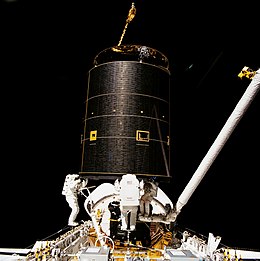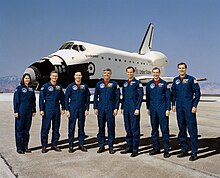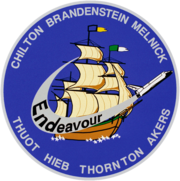STS-49

Mission Specialists Richard Hieb, Thomas Akers and Pierre Thuot capture the Intelsat 603 satellite during STS-49
|
|
| Mission type | Satellite repair |
|---|---|
| Operator | NASA |
| COSPAR ID | 1992-026A |
| SATCAT no. | 21963 |
| Mission duration | 8 days, 21 hours, 17 minutes, 38 seconds |
| Distance travelled | 5,948,166 kilometers (3,696,019 mi) |
| Orbits completed | 141 |
| Spacecraft properties | |
| Spacecraft | Space Shuttle Endeavour |
| Landing mass | 91,214 kilograms (201,092 lb) |
| Payload mass | 14,618 kilograms (32,227 lb) |
| Crew | |
| Crew size | 7 |
| Members |
Daniel C. Brandenstein Kevin P. Chilton Richard J. Hieb Bruce E. Melnick Pierre J. Thuot Kathryn C. Thornton Thomas D. Akers |
| Start of mission | |
| Launch date | 7 May 1992, 23:40:00 UTC |
| Launch site | Kennedy LC-39B |
| End of mission | |
| Landing date | 16 May 1992, 22:57:38 UTC |
| Landing site | Edwards Runway 22 |
| Orbital parameters | |
| Reference system | Geocentric |
| Regime | Low Earth |
| Perigee | 268 kilometres (167 mi) |
| Apogee | 341 kilometres (212 mi) |
| Inclination | 28.35 degrees |
| Period | 90.6 min |
 Left to right: Thornton, Melnick, Thuot, Brandenstein, Chilton, Akers, Hieb |
|
STS-49 was the maiden flight of the Space Shuttle Endeavour. The primary goal of its nine-day mission was to retrieve an Intelsat VI satellite (Intelsat 603, which failed to leave low earth orbit two years before), attach it to a new upper stage, and relaunch it to its intended geosynchronous orbit. After several attempts, the capture was completed with a three-person extra-vehicular activity (EVA). This was the first time that three people from the same spacecraft walked in space at the same time, and as of 2014[update] it was the only such EVA. It would also stand until STS-102 in 2001 as the longest EVA ever undertaken.
The Intelsat 603 satellite, stranded in an unusable orbit since launch aboard a Commercial Titan III rocket in March 1990, was captured by crewmembers during an EVA (extra-vehicular activity) and equipped with a new perigee kick motor. The satellite was subsequently released into orbit and the new motor fired to put the spacecraft into a geosynchronous orbit for operational use.
The capture required three EVAs: a planned one by astronaut Thuot and Hieb who were unable to attach a capture bar to the satellite from a position on the RMS; a second unscheduled but identical attempt the following day; and finally an unscheduled but successful hand capture by Thuot, Hieb and Akers as commander Brandenstein delicately maneuvered the orbiter to within a few feet of the 4215 kg communications satellite. An Assembly of Station by EVA Methods (ASEM) structure was erected in the cargo bay by the crew to serve as a platform to aid in the hand capture and subsequent attachment of the capture bar.
...
Wikipedia

